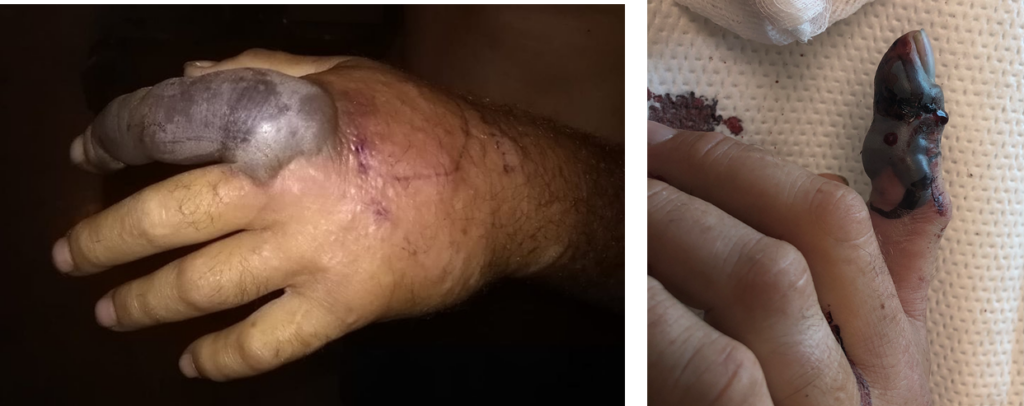Certain snakes elicit powerful, visceral responses in people. Some folks picture that dramatic scene in “Lonesome Dove” when they think about cottonmouths. Maybe younger people recall Mahershala Ali’s character from the TV show “Luke Cage.” Similarly, “Snakes on a Plane,” “Raiders of the Lost Ark,” and “Kill Bill” all feature serpents that provoke strong emotions.
And then there is a copperhead, the Rodney Dangerfield (born Jacob Rodney Cohen) of snakes. These guys really get no respect. How so? Their envenomations are often minimized by both laypeople and healthcare professionals. As someone who treats a ton of copperhead bites, I find this attitude frustrating and dangerous.
If you remember nothing else after reading this blog, remember this: Copperhead envenomations should be taken seriously. It is true that very few people die from copperhead envenomations. Then again, death following any snakebite in United States is relatively rare. There is a mean of 3.4 deaths annually, which includes a significant number of victims who do not seek medical attention. That said, people can die from copperhead envenomations. In the study I authored looking at fatal snakebites in United States between 1989 and 2018, we identified five fatalities attributed to copperhead bites. In 2019 there was an additional death.
Because death is highly unlikely after snakebite, it is not a sensitive measure of envenomation severity. We also worry about local damage, hematologic laboratory abnormalities, and systemic toxicity. As someone who treats many copperhead envenomations, I can attest to how much significant local injury is possible. These photos are just a few examples of confirmed copperhead envenomations. Hematologic laboratory abnormalities are observed in anywhere from 14% to 63% of patients, depending on the study. Fortunately, these are usually clinically insignificant.
Another thing to remember about copperhead envenomations is that the local disability and disfigurement can be prolonged or even permanent, particularly if they are not treated correctly. I often see snakebite patients in outpatient clinic who were “treated” (although often without antivenom) elsewhere, and they have significant effects even several months later.
One I’ll never forget was a woman in her 30s. Before her copperhead envenomation, she was an avid triathlete. When she was bitten, her local swelling and tenderness extended from her toe to her proximal thigh. She did not receive antivenom. I saw her ~6 months after her bite. She couldn’t stand for long periods without developing significant foot and leg swelling. She couldn’t walk fast without discomfort. She couldn’t run, and she certainly could not run competitively.
Would antivenom have prevented all of this? Not necessarily, but it would have maximized her likelihood of a faster and more complete recovery.
Hesitation to treat copperhead envenomation with antivenom is partially based on an outdated understanding of the risks and benefits.
Equine (horse) derived, whole-IgG antivenom products available before 2000 had a high incidence of acute adverse reactions, leading many clinicians to think that, at least for copperhead envenomation, the cure was worse than the disease. However, the safety of antivenom greatly improved with the introduction of CroFab in 2000. This ovine (sheep)-derived, antibody fragment product uses a unique purification process, and has been proven far less likely to elicit allergic reactions.
Clinicians may also have hesitated to treat copperhead envenomations with antivenom because for many years there was no actual proof that antivenom was beneficial; copperhead bites were excluded from the initial CroFab studies in the 1990s. However, in 2016 we published a randomized clinical trial (RCT) demonstrating that copperhead envenomations recover faster when they are treated with CroFab. Importantly, recovery was defined using a patient-centric metric. Subanalyses of the RCT proved that early treatment of copperhead envenomation with antivenom was especially beneficial, and opioid requirements were less in patients who received antivenom, which is important in the midst of a growing opioid abuse epidemic.
This result should not be surprising as CroFab was designed to neutralize the protein components in copperhead venom. Four species of North American snakes were specifically selected for use in manufacturing CroFab, allowing it to counter the broad spectrum of venom toxins exhibited by all pit vipers found in the U.S. Among these, cottonmouths were chosen for the abundance of specific Phospholipase A2 isoforms – enzymes also prominent in copperhead venom.
One other thing to consider. People who make decisions based on the suspected snake species may not even be identifying the snake correctly! In areas where multiple snakes species are found, misidentification is common.
What I want you to remember is this: Any pit viper bite has the potential to be mild, moderate, severe, or even fatal. Think (potentially) dangerous, not Dangerfield, when it comes to copperheads, and treat the patient based on the clinical features, not the suspected culprit.


